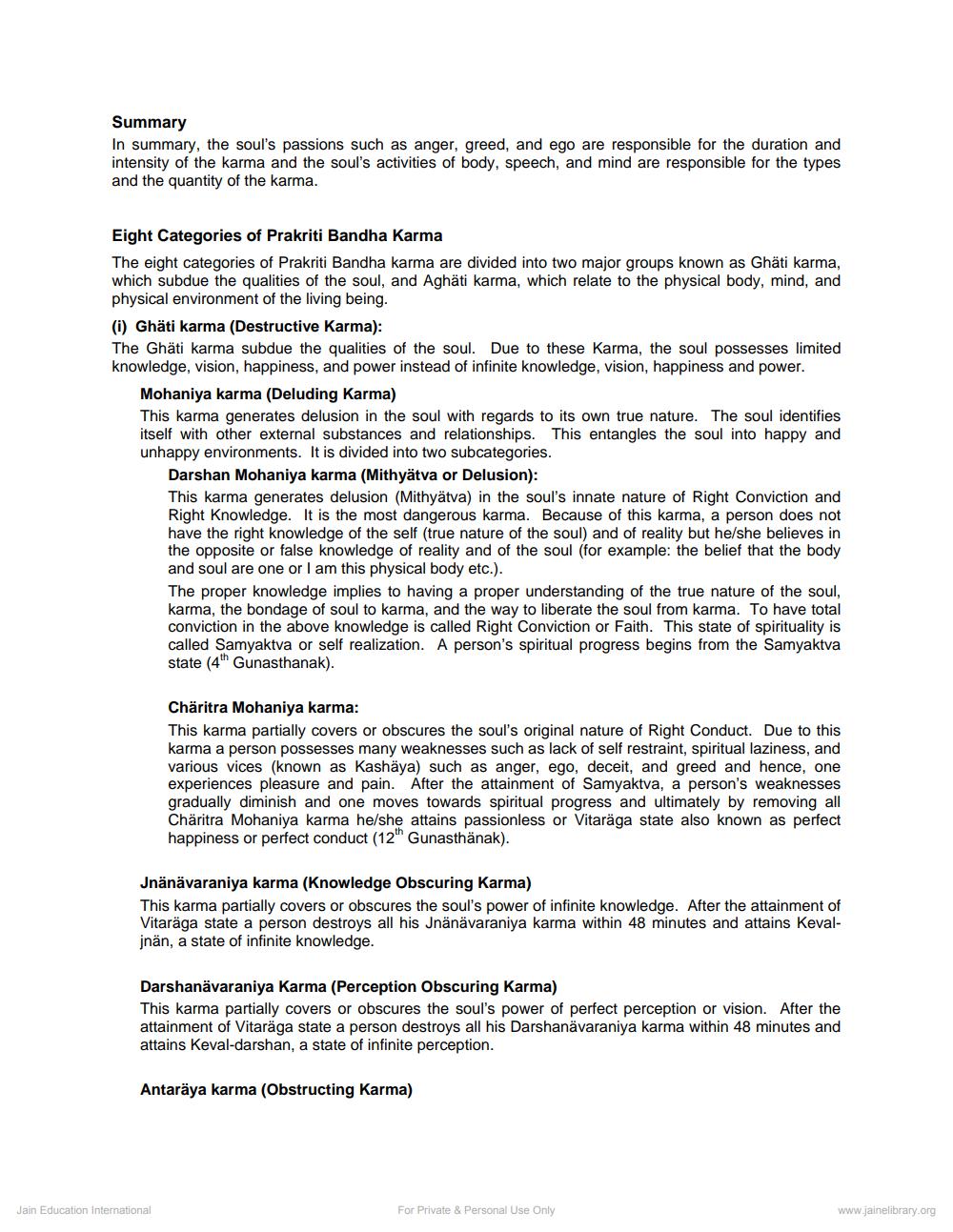Book Title: Nine or Nav Tattvas Author(s): Jaina Education Publisher: JAINA Education Committee View full book textPage 3
________________ Summary In summary, the soul's passions such as anger, greed, and ego are responsible for the duration and intensity of the karma and the soul's activities of body, speech, and mind are responsible for the types and the quantity of the karma. Eight Categories of Prakriti Bandha Karma The eight categories of Prakriti Bandha karma are divided into two major groups known as Ghäti karma, which subdue the qualities of the soul, and Aghäti karma, which relate to the physical body, mind, and physical environment of the living being. (i) Ghäti karma (Destructive karma): The Ghäti karma subdue the qualities of the soul. Due to these Karma, the soul possesses limited knowledge, vision, happiness, and power instead of infinite knowledge, vision, happiness and power. Mohaniya karma (Deluding Karma) This karma generates delusion in the soul with regards to its own true nature. The soul identifies itself with other external substances and relationships. This entangles the soul into happy and unhappy environments. It is divided into two subcategories. Darshan Mohaniya karma (Mithyätva or Delusion) This karma generates delusion (Mithyätva) in the soul's innate nature of Right Conviction and Right Knowledge. It is the most dangerous karma. Because of this karma, a person does not have the right knowledge of the self (true nature of the soul) and of reality but he/she believes in the opposite or false knowledge of reality and of the soul (for example: the belief that the body and soul are one or I am this physical body etc.). The proper knowledge implies to having a proper understanding of the true nature of the soul, karma, the bondage of soul to karma, and the way to liberate the soul from karma. To have total conviction in the above knowledge is called Right Conviction or Faith. This state of spirituality is called Samyaktva or self realization. A person's spiritual progress begins from the Samyaktva state (4h Gunasthanak). Charitra Mohaniya karma: This karma partially covers or obscures the soul's original nature of Right Conduct. Due to this karma a person possesses many weaknesses such as lack of self restraint, spiritual laziness, and various vices (known as Kashaya) such as anger, ego, deceit, and greed and hence, one experiences pleasure and pain. After the attainment of Samyaktva, a person's weaknesses gradually diminish and one moves towards spiritual progress and ultimately by removing all Charitra Mohaniya karma he/she attains passionless or Vitaraga state also known as perfect happiness or perfect conduct (12" Gunasthänak). Jnänävaraniya karma (Knowledge Obscuring Karma) This karma partially covers or obscures the soul's power of infinite knowledge. After the attainment of Vitaraga state a person destroys all his Jnänävaraniya karma within 48 minutes and attains Kevaljnän, a state of infinite knowledge. Darshanävaraniya Karma (Perception Obscuring Karma) This karma partially covers or obscures the soul's power of perfect perception or vision. After the attainment of Vitaraga state a person destroys all his Darshanävaraniya karma within 48 minutes and attains Keval-darshan, a state of infinite perception. Antaräya karma (Obstructing Karma) Jain Education International For Private & Personal Use Only www.jainelibrary.orgPage Navigation
1 2 3 4 5 6 7 8
